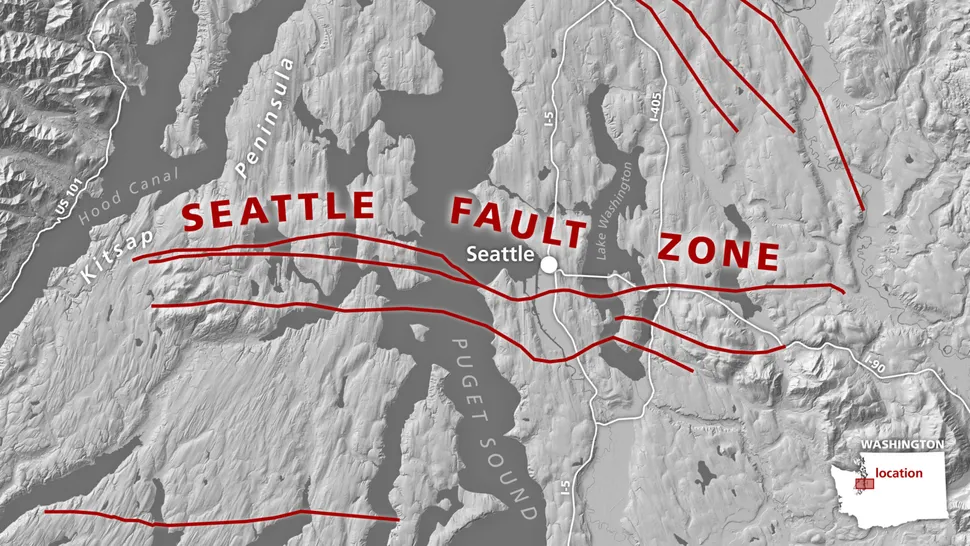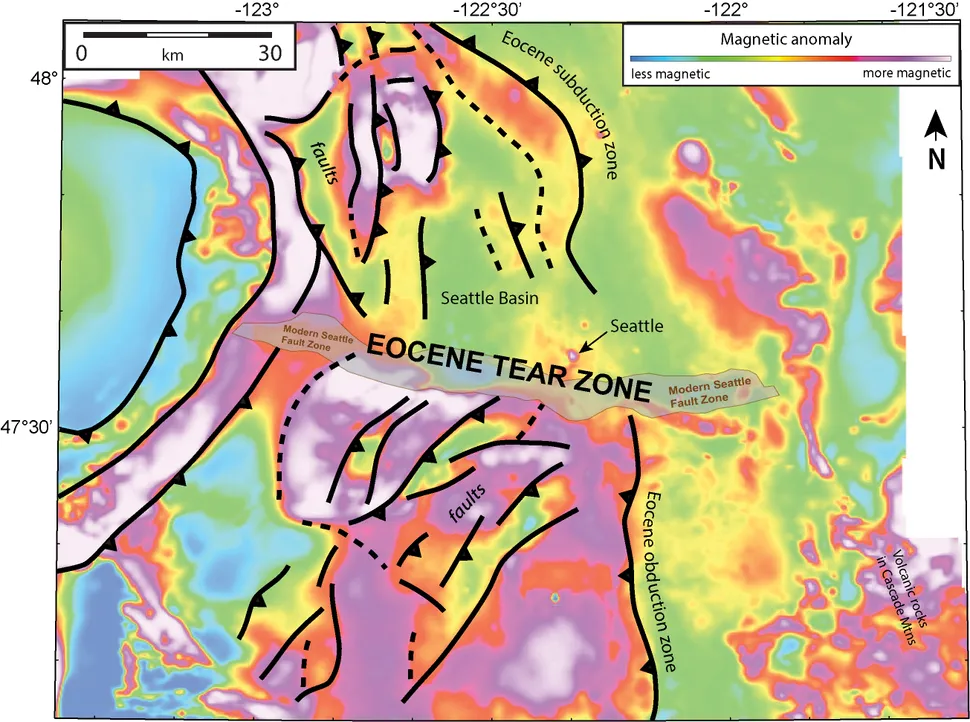Seattle’s enormous fault possibly caused by oceanic crust ‘unzipping’ 55 million years ago
Magnetic data suggest Seattle’s fault line formed 55 million years ago, when the southern half of a subducting chain of volcanic islands piled onto the continent and tore apart from the northern half.
According to a recent study, it is suggested that a dangerous fault line, located south of downtown Seattle, may have originated when the North American continent experienced a rupture approximately 55 million years ago. Seattle is situated above the Cascadia Subduction Zone, where the Explorer, Juan de Fuca, and Gorda tectonic plates slide beneath the significantly larger North American Plate. As a result of this eastward movement, a series of volcanic islands, similar to present-day Iceland, were pulled towards the continent, leading to a collision that is still evident in the underlying bedrock beneath the city.
Newly created maps of this bedrock provide insights into the chaotic nature of this collision. The northern half of the island chain was found to have ridden the oceanic crust and slipped beneath the continent, while the southern half piled onto the continent. The point at which the islands transitioned from being subducted to being added to the top of the continent created a twist in the Earth’s crust. This twist would have experienced immense strain and likely resulted in a rupture, tearing it apart.
In a statement, Megan Anderson, a geophysicist with the Washington Geological Survey and the lead author of the study, described the tearing process as a slow and ongoing one, resembling the unzipping of a crust. As the tear fault progressed, it gradually extended in length.
The tearing likely came to an end when the islands finished compressing into the continent. To test this hypothesis, Anderson and her colleagues utilized computer models and discovered that the resulting gap in the Earth’s crust perfectly aligned with Seattle’s fault line. Furthermore, the wear and tear experienced by the surrounding crust matched with a network of shallow faults beneath the densely populated Puget Lowland area.

Previous research on the region’s fractured geological history relied on seismic data, which involves the analysis of sound waves traveling at different speeds underground, depending on the rock layers they encounter.
For their new study, published on February 6 in the journal Tectonics, the researchers employed gravity and magnetic-field measurements to map the density and composition of rocks beneath western Washington state. They then combined these findings with seismic data and collected rock samples to gain a comprehensive understanding of the area’s geology.

The magnetic data has provided valuable insights that seismic data alone could not have revealed. It has uncovered the fact that the magneticity within the bedrock alternates, and that the rocks on either side of the Seattle fault line are angled away from each other. The slabs of rock to the north of the fault line are positioned in a northwest-to-southeast diagonal, while the slabs to the south are angled from northeast to southwest.
According to Anderson, these orientations are significantly different. He explains that such variations would be difficult to occur unless there was a point where the structures became disconnected and then restarted.
These findings suggest a new explanation for the origin of the Seattle fault line, which could greatly assist scientists in refining their earthquake hazard models. The most recent destructive earthquake in western Washington state was the Nisqually earthquake in 2001, which had a magnitude of 6.8. Additionally, significant earthquakes also occurred in 1700 and around A.D. 900, when multiple faults ruptured simultaneously, causing tremors in the Seattle area.
Anderson emphasizes that there is much more uncertainty surrounding the Seattle fault compared to the well-known San Andreas fault. The Seattle fault has the potential to generate an earthquake of approximately magnitude 7.2, and it is crucial to be prepared for such an event. There is still a great deal to learn in order for engineering geologists to improve earthquake simulations and fully comprehend the potential risks to our communities.
This article is republished from livescience under a Creative Commons license. Read the original article.
Do not forget to share your opinion with us to provide you with the best posts !




0 Comments